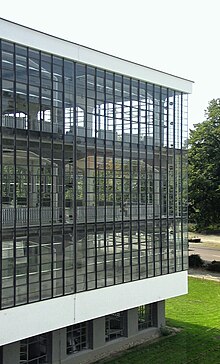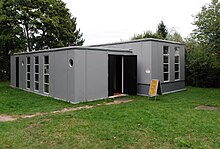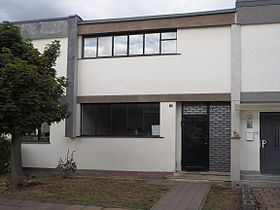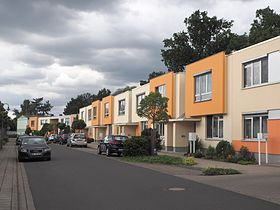User:Architect21c/BD





The Bauhaus Dessau Buildings are a series of buildings designed by Walter Gropius and other leaders of the Bauhaus School in Dessau, Germany in the 1920's and early 1930's. The Bauhaus Building was erected for the Bauhaus school of art, design, and architecture and today is home to the Bauhaus Dessau Foundation. Both its design and educational program are recognized as seminal in the development of the international style architecture and design, what later became the dominant form of modernist architecture. It was a highly influential building whose design became a prototype for many forms of commercial, institutional, governmental, and educational buildings around the world throughout the latter half of the 20th century.[1] Gropius and subsequent members of the Bauhaus School designed "Master Houses" for the leaders of the school and a new worker-housing development in the south of Dessau, the Torten Estate.
The buildings were constructed in the 1920's and the school operated until 1932, when it was ordered closed by the German Nazi government. The buildings were partially destroyed during World War II. Beginning in the mid-1950's they were re-built and partially restored, and between 1996 and 2006 many were restored using historic preservation principles. In 1996 the Bauhaus sites in Dessau and Weimar were designated as UNESCO World Heritage sites.
Bauhaus Building[edit]
Description[edit]
The in international style constructed building consists of five additive arranged in wing shape, functionally structured parts: a wing building of the "Arts and Crafts School" (later technical colleges), the workshop wing with its distinctive glass curtain facade ( Curtain Wall ) and the studio house. In Atelierhaus the residential workshops for the students are accommodated. The north wing of the trade school and the workshop wing are 'connected by a two-storey' 'bridge'. This bridge was intended (the architecture department of the Bauhaus later) for administrative offices and the site office of Gropius. In a flat construction between workshop wing and studio are Hall and stage and the cafeteria of the Bauhaus.
What makes the whole complex is next to the then novel functional separation by single, attached to an organism individual buildings, which completely resolved in glass wall of workshops tract that made in the time of great excitement. The props of the building are completely back from the glass facade, so that the glass apron over all three bullet s and the entire length of the building is enough and will not be interrupted. There is the impression of transparency, lightness and flatness. This novel, transparent monumentality had overcome all prevailing ideas of aesthetics.
Ornamentlessness determined remains true to the whole complex. By "open" facade is a new, pedagogically effective relationship between inside and outside, gives the impression of freedom and clarity. However, the delicate glass façade (curtain wall) in steel caused great problems regarding sunscreen and building climate. In summer, the building heated due to direct sunlight on enormously. A necessary sun protection system of curtains in turn destroyed intention transparency. In winter, the building cooled due to the single glazing in very quickly and had to be strongly heated. The ventilation via mechanically controlled, very elaborate in detail louvers wing.
"it was a framework for the creative energy of the school. Its stairs, workshops and balconies were places of display as well as function, and its glass walls made a spectacle of its internal activities. One of the key spaces was an auditorium whose stage is connected to the communal canteen, thereby bringing together performance and life. It also has a subtle colour scheme, contrary to Wolfe's assertions that the Bauhaus was only interested in black, white and grey. If it looked like a factory it also had properties of a commune, a cult centre and a theatre."[1]
Features[edit]
1911 designed Gropius and Meyer together the Fagus Factory s in Alfeld (Leine). They used elements that should be characteristic and stylish determinative later: The entire building was functional divided. Its use certain shape; its aesthetics resulted from its functionality. The facade ngestaltung hinted future use. The revolutionary steel skeleton construction - supporting steel elements with brick infill covered by a flat roof - allowed the waiver of static gain of the building corners. This "open corners" were replaced by kantenumgreifende glazing and balconies, providing a comprehensive impression of lightness. The curtain glass facade (Curtain Wall) was itself not a burden, but showed the supporting elements themselves formative parts were like that. The coloration also went to new ways. The outer walls were decorated in neutral, plain white, inside differentiated colors between supporting and fairing elements. Each of the thirteen workshops made its specific contribution, as art and craft also had a & nbsp;. A. Metal workshop, carpentry, stained glass, weaving, Mural, harmonization doctrine, united by led by Gropius, Meyer and later van der Rohe architecture workshop.
History[edit]
The Bauhaus was in 1919 replaced by the new leadership of Walter Gropius, the Henry van de Velde, as a follow-up institution founded by the Grand Duke of Saxe-Weimar in 1906 Art school or Kunstgewerbeschule Weimar renamed and reorganized. Its head was from 1919 to 1928, the architect Walter Gropius. After the relationship with the increasingly right-wing political forces dominated Thuringian state had become increasingly critical, the Bauhaus had to be resolved in 1925 to political pressure. The declaration of dissolution was published on 29 December 1924 in many newspapers. However, it was only after the expiry of contracts that had 1925 valid until March 31, legally. The Mayor of Dessau, Fritz Hesse, and his cultural adviser Ludwig Grote enabled Gropius the relocation of the school to Dessau, where the Bauhaus in the years 1925 to 1926 draft was rebuilt by Gropius and 1926, recognized as a National School of Anhalt.
Emergence[edit]
In March 1925, the Office Gropius was commissioned by the city of Dessau commissioned the community building of the Arts and Crafts School Dessau (1926 Technical colleges) and the Bauhaus design. In September 1925 the construction of the common school building. On March 21, 1926 was the topping and on 4 December 1926, the inauguration. Master and Bauhaus workshops had planned large parts of the device itself and carried out: furniture and fixtures were from the joinery (seating of the assembly hall of Marcel Breuer). The lamps were designed in the metal workshop (illuminant in the auditorium of Max Krajewsky[2]), upholstery fabrics and curtain fabrics originated in the own weaving. The labels came from the advertising workshop and the color design of the mural workshop.
With the foundation in 1926 for the first time an architectural department was set up, its management in 1927 the Swiss Hannes Meyer took over. 1928 Gropius resigned from the line. The strong political commitment Hannes Meyer took over on April 1, 1928 his successor and built the architecture department from further, but was also dismissed for political reasons on 1 August 1930's. He was succeeded by Ludwig Mies van der Rohe, which, despite technical-scientific strengthening the school failed, keep the Bauhaus out of the political turmoil.
Nazi period[edit]
1931, well over a year before Hitler seizure, the NSDAP won in the municipal elections in Dessau 15 of the 36 seats and was the strongest faction. In her pamphlet on the elections on 25 October 1931, the Nazis demanded as the first of eight points:
"Immediate cancellation of all expenditure for the Bauhaus. Foreign teachers are with immediate effect, since it is incompatible with the responsibility of having to wear a good community leadership to their citizens that German countrymen starve while foreigners are paid in überreichlichem extent of the tax dollars of starving people. German teachers are elsewhere accommodate through the mediation of the church in Dessau or. For the craftsmen schools located in Bauhaus accommodation is creating elsewhere. The demolition of the Bauhaus to be passed immediately in the way "[3]
The NSDAP demanded in the council meeting on January 21, 1932 demolition of the building. This and the decision on cancellation of funds could still be almost prevented. On 8 July 1932, the Prime Minister of the Free State Anhalt visited elected National Socialist Alfred Freyberg and the National Socialist art theorist and architect Paul Schultze-Naumburg, the Bauhaus Dessau . Because in the meantime had changed the voting conditions in the council, took place on 22 August 1932 on application of the NSDAP fraction of the decision to close. Mies van der Rohe tried to continue as a private institution in lankwitz; But a short time later (1933) was forced the institution by the Nazis ultimately become self-dissolution. The building served as Gauführerschule in Gau Magdeburg-Anhalt[4]
Post World War II[edit]
1945 burned the building after the heavy air raid on Dessau partly from the glass façade of the workshop wing was destroyed. It was built in simplified form (the glass curtain wall was not reconstructed), and & nbsp;. A. used as a vocational school.
1976 was a first attempt to restore the original appearance, which also destroyed the glass curtain wall based on a spare piece obtained reconstructed was. It was used for the sake of maintainability aluminum instead of steel.
1994-1996[edit]
Since 1994, the building in Dessau seat of Bauhaus Dessau Foundation that "to preserve the legacy of the historic Bauhaus and to convey to the public" and "to make the face of this heritage contributions to the design of today's living environment" is obliged [5]. Since 1996, the building complex in the list of World Heritage s of UNESCO is entered.
Repair 1996-2006[edit]
Between 1996 and 2006, the Bauhaus Dessau [6]
The Bauhaus Dessau is incorporated into the Blue Book 2,001th The Blue Book is a list of nationally significant cultural institutions in East Germany and currently includes 20 so-called cultural beacons.
After the last repairs were completed in 2009, the building could be re-inspected nearly so, as it was originally designed and built. Nevertheless, there are differences from the original structure, the modern necessities and historic preservation considerations are not dissolve due to the turbulent history of the building. These include:
- The glass facade of the workshop building was originally crystal glazed and mirrored so much stronger than today's glass from normal glass. In old photos Lucia Moholy the original idea is still preserved.
- Furniture and door handles have been partially replaced by the original as possible replicas. This was among other favored because some of the old designs are produced today again industrially. Other items such as the seating in Aula are new one-offs.
. * The used at the time building materials ien were partly experimentally, so they require a permanent repair, such & nbsp; B. Floors from magnesite flooring or Triolin.
- The building was re-electrified.
[- Environment Bauhaus Dessau photos http://www.competitionline.com/de/projekte/49164 Implemented project] transformed </ref> * As part of a fundamental reorganization of the environment and the grounds Cite error: A <ref> tag is missing the closing </ref> (see the help page).
Current Use[edit]
Today the majority of the building complex of the Bauhaus Dessau Foundation is used for offices. The Bauhaus also has its own library. The former student apartments on the balcony side of the east wing are rented as apartments. Furthermore, there is a lease agreement with the Hochschule Anhalt. Currently, six rooms on the ground floor area of the north wing for teaching activities are exploited.
In workshops wings of classrooms Bauhauskolleg , the postgraduate program of the Bauhaus Dessau Foundation, housed. Interdisciplinary, international study groups develop here solutions to problems of architecture and urbanism. In addition, the coordinating body of the International Building Exhibition Urban Redevelopment Saxony-Anhalt 2010 is housed, developed the concepts for urban problems in Sachsen-Anhalt.
Master houses[edit]

Seven "Master Houses" of the directors of the school.
Near the Bauhaus (Ebert Allee 65-71, built Walter Gropius the 'Masters' as accommodation for the Bauhaus masters. There were the same Sample houses for modern living. The client was the city of Dessau, the Bauhaus masters lived for rent.
From east to west, it was the single house Gropius, and in each case the double houses Moholy-Nagy / Feininger, Muche / Schlemmer [7] and Kandinsky / Klee. The three semi-detached houses had identical floor plans in which one half was almost turned by 90 degree mirror image of the other in each case.
Characteristic of the architecture of the houses, the cubic form with a flat roof, large, solid colors and large windows that connect between inside and outside. This compound is also addressed by the large terraces and balconies and the many doors: From almost every room, it is possible to pass through a door to the outside.
The Masters' Houses of Gropius and Moholy-Nagy were destroyed by a bombardment 1945th In the 1950s, a house was built in a traditional gable roof construction (Emmer House) on the foundations of the destroyed house Gropius. The bombed house of Moholy-Nagy was removed and created an open space so that the Feininger House stood alone (currently it is from Kurt Weill Centre used).
The remaining houses were after 1990 z. T. extensively restored with private funds. It has also been attempted, the original colors of the interiors, which went back to the color theory of the Bauhaus restore. Since the color design of the interior also by their inhabitants depended, are found on the premises today exemplary color schemes that try each reproduce only the state of a room at a certain time.
Meanwhile, the war-damaged master houses Gropius and Moholy-Nagy [David Chipperfield] [] been built out under the leadership of the Berlin office Bruno Fioretti Marquez as abstract interpretations of the original architecture back at the suggestion of British Architects. The interior walls were designed by the conceptual artist Olaf Nicolai with different plaster types and shades of white, which depending on the light a changing impression ergibt.[8] The official reopening of the Masters' Houses took place on May 16, 2014 German President Gauck. [9] The earlier discussion of whether the houses are to be reconstructed faithfully, [10] is thus obsolete.
A built in the vicinity of the Masters' Houses Estate, designed by Ludwig Mies van der Rohe Trinkhalle was discontinued in the 1970s. 2013 Trinkhalle was rebuilt as part of the urban repair the Masters' Houses Estate.
-
Emmer House, demolished in 2011
-
Gropius House, reconstructed in 2014
-
House Moholy-Nagy / Feininger (reconstructed 2014)
-
House Moholy-Nagy / Feininger (until 2011)
-
Muche / Schlemmer
-
House Kadinsky / Klee
-
Trinkhalle
Törten Estate and Balcony Access Houses[edit]
Bauhaus, Dessau - Torten Estate
"In Dessau, Gropius and his followers could also try out other architectural ideas on the row of houses built for Bauhaus masters, and on 300 low-cost houses built for industrial workers on the Dessau-Torten estate."[1]
Furthermore, a development of terraced houses (large ring, center ring, small ring) and 1930, the Balcony Access Houses (middle width, Peterholzstr.) Originated in Törten in today Dessau-Süd 1926/1928 in industrial construction. Here essential conceptions of the architects of the Bauhaus as sunlight at different times and seasons, the life processes in a residential building and the use of the surrounding gardens for their own care and the rest were considered. Here was implemented, which Walter Gropius had already formulated: Building the figures of life processes. The industrial design, low prices have been achieved, which should allow for the buyer a way out of the rising rents through purchase of one's home. Because of the flat roof construction, the houses of conservatives were strongly criticized.
The settlement has undergone numerous subsequent changes. In particular, the windows are almost entirely changed. Numerous individual facade designs have the original uniform impression of the settlement that is in spite of these tags still well preserved softened. The house at the center ring 35 has been faithfully restored from 1992 as the first. It is now used by the Moses Mendelssohn Society and is besichtigen.[11]
The resulting 1928 to a design by Walter Gropius' Dessau Konsum building (a kind of converted department store) became a center of the Törten he settlement. It consists of two nested cubes, a horizontal loading portion and a vertical three-storey residential part. It is still used today. In the former part of the store is now home to an information center for Törten that offers tours daily.
-
Törten settlement - detached
-
Törten - detached in the original position - center ring 35
-
Törten - Dessau Konsum consumers cooperative
-
Törten - Stylistically adapted new buildings at Great Ring
-
Portico home
Other buildings[edit]
Near the settlement, in South Street, is the House Fieger . Built in the summer of 1927 House is the only unconverted design of Carl Fieger from a set of plans for small homes that may arise in a rational construction with versatile spaces. When privately used dwelling house, it is not visible.

The so-called Steel House was built in the years 1926/1927 and was a joint project of Richard Paulick and the Bauhaus masters Georg Muche. They wanted to continue the rationalization efforts of Walter Gropius (prefabrication of concrete elements) by use prefabricated steel plates in a drying method of assembly. However, the steel house remained an experiment, because it had much to fight because of the properties of the material with the "warm-cold problem". After restoration was inside to June 2011 above mentioned an information center for Törten. Today it can be visited as part of held daily tours.

The former Labour Office was the first urban 'job center' '(now the order and traffic of the city Dessau) arose 1928/1929 designed by Walter Gropius. The private site office of Gropius stated also the construction. Richard Paulick was instrumental in the construction of the labor office whose external impression, however, was changed significantly by subsequently used wooden windows.
The Kornhaus (granary) was commissioned by the city of Dessau and the Schultheiss Patzenhofer brewery built 1929/1930 directly on the dike designed by Carl Fieger. The name recalls an old granary, standing here right at the same of the mid-18th century to the 1870s. The building is still used as a restaurant.
See also[edit]
- Kirsten Baumann: Bauhaus Dessau. Architecture, design, idea. Jovis, Berlin 2007, ISBN 978-3-939633-11-2.
- Christian Irrgang: The Bauhaus building in Dessau (Edited by Bauhaus Dessau Foundation, Project Manager Jutta Stein) Spector Books, Leipzig 2014, ISBN 978-3-940064-71-4 (= Bauhaus Bag Belly , Volume 5).
- Wolfgang Thöner: The Bauhaus. Guide through his buildings in Dessau. Edition RK, Dessau 2006 ISBN 978-3-934388-19-2.
External links[edit]
{Commonscat}
- {Sketchup | abebe77b0a77ed5dcbc85b0c9af740da}
- Bauhaus Dessau Foundation
- Meisterhäuser
- For more information on Master Feininger House in the article in Monuments Online
- Bauhaus Club (Foundation for Bauhaus Dessau and present)
- Photo Report Bauhaus and master houses in Dessau
- report of the exhibition "Bauhaus: Dessau, Chicago, New York", /2000/okt2000/bau2-o20.shtml part 2
- A journey through the Dessau Bauhaus
- Interview with Professor Philipp Oswalt, director of the Bauhaus Dessau Foundation, about the Bauhaus 90 years ago and today at [[Monument] ] online
References[edit]
- ^ a b c [http://www.theguardian.com/artanddesign/2012/apr/13/bauhaus-dessau-barbican-rowan-moore
- ^ ERCO Lichtbericht 12
- ^ leaflet displayed in:. Philipp Oswalt (ed.): Dessau destroyed 1945. Modern , 2014. ISBN 978-3-944669-57-1
- ^ Photo
- ^ The Bauhaus Dessau Foundation today
- ^ [MDR] [Central German Broadcasting] is set and restored service for 17 million euros according to the plans of the 1920s and findings. url = http: //www.mdr.de/mdr-figaro/journal/3821015.html | wayback = 20061205084703 |title= Bauhaus Dessau: The icon of modernity is 80}}
- ^ Harald Stein Mart: an unattractive braggart house THE PERIOD 16 July 2009 # . 30
- ^ http://www.deutschlandradiokultur.de/architektur-ikonen-der-moderne-revisited.954.de.html
- ^ Meisterhäuser at Bauhaus Dessau reopened
- ^ backgrounds for Dessauer reconstruction debate on monument debates
- ^ The settlement Dessau-Torten by Walter Gropius
51°50′21″N 12°13′36″E / 51.83917°N 12.22667°E
[Category: Building in Anhalt | Dessau-Roßlau]] [Category: Bauhaus and its sites in Weimar and Dessau]] [Category: Structure of the Bauhaus style]] [Category: Built in the 1920s]] [Category: Building in Dessau]] [Category: cultural monument in Dessau]] [Category: Structure of modernity in Saxony-Anhalt]] [Category: Structure of Walter Gropius]]












